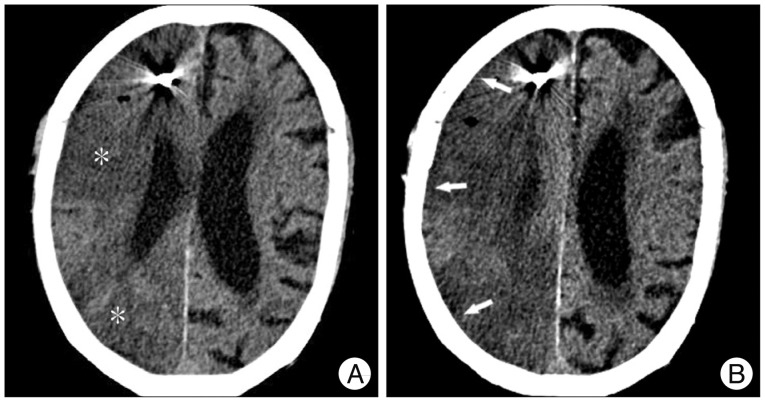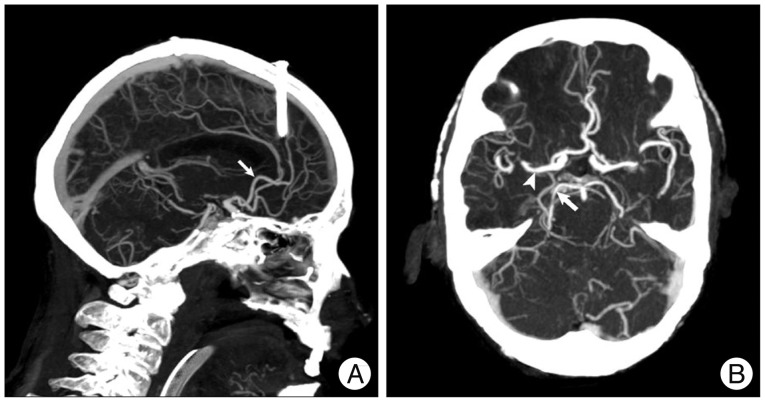J Korean Neurosurg Soc.
2014 May;55(5):293-295. 10.3340/jkns.2014.55.5.293.
Post-Traumatic Cerebral Infarction Following Low-Energy Penetrating Craniocerebral Injury Caused by a Nail
- Affiliations
-
- 1Department of Emergency Medicine, Tri-Service General Hospital, National Defense Medical Center, Taipei, Taiwan. qqww0139@yahoo.com.tw
- KMID: 2018038
- DOI: http://doi.org/10.3340/jkns.2014.55.5.293
Abstract
- Post-traumatic cerebral infarction (PTCI) is a secondary insult which causes global cerebral hypoxia or hypoperfusion after traumatic brain injury, and carries a remarkable high mortality rate. PTCI is usually caused by blunt brain injury with gross hematoma and/or brain herniation. Herein, we present the case of a 91-year-old male who had sustained PTCI following a low-energy penetrating craniocerebral injury due to a nail without evidence of hematoma. The patient survived after a decompressive craniectomy, but permanent neurological damage occurred. This is the first case of profound PTCI following a low-energy penetrating craniocerebral nail injury and reminds clinicians of possibility this rare dreadful complication for care of head-injured patients.
Keyword
MeSH Terms
Figure
Reference
-
1. Arutiunov AI, Baron MA, Majorova NA. The role of mechanical factors in the pathogenesis of short-term and prolonged spasm of the cerebral arteries. J Neurosurg. 1974; 40:459–472. PMID: 4814377.
Article2. Beaumont A, Marmarou A, Hayasaki K, Barzo P, Fatouros P, Corwin F, et al. The permissive nature of blood brain barrier (BBB) opening in edema formation following traumatic brain injury. Acta Neurochir Suppl. 2000; 76:125–129. PMID: 11449990.
Article3. Dore-Duffy P, Wang S, Mehedi A, Katyshev V, Cleary K, Tapper A, et al. Pericyte-mediated vasoconstriction underlies TBI-induced hypoperfusion. Neurol Res. 2011; 33:176–186. PMID: 21801592.4. Guerra WK, Gaab MR, Dietz H, Mueller JU, Piek J, Fritsch MJ. Surgical decompression for traumatic brain swelling : indications and results. J Neurosurg. 1999; 90:187–196. PMID: 9950487.
Article5. Ham HY, Lee JK, Jang JW, Seo BR, Kim JH, Choi JW. Post-traumatic cerebral infarction : outcome after decompressive hemicraniectomy for the treatment of traumatic brain injury. J Korean Neurosurg Soc. 2011; 50:370–376. PMID: 22200021.
Article6. Howard JL, Cipolle MD, Anderson M, Sabella V, Shollenberger D, Li PM, et al. Outcome after decompressive craniectomy for the treatment of severe traumatic brain injury. J Trauma. 2008; 65:380–385. discussion 385-386. PMID: 18695475.
Article7. Kishore K, Sahu S, Bharti P, Dahiya S, Kumar A, Agarwal A. Management of unusual case of self-inflicted penetrating craniocerebral injury by a nail. J Emerg Trauma Shock. 2010; 3:193–196. PMID: 20606802.
Article8. Menon DK, Coles JP, Gupta AK, Fryer TD, Smielewski P, Chatfield DA, et al. Diffusion limited oxygen delivery following head injury. Crit Care Med. 2004; 32:1384–1390. PMID: 15187523.
Article9. Mirvis SE, Wolf AL, Numaguchi Y, Corradino G, Joslyn JN. Posttraumatic cerebral infarction diagnosed by CT : prevalence, origin, and outcome. AJNR Am J Neuroradiol. 1990; 11:355–360. PMID: 2107719.10. Selvanathan S, Goldschlager T, McMillen J, Campbell S. Penetrating craniocerebral injuries from nail-gun use. J Clin Neurosci. 2007; 14:678–683. PMID: 17452105.
Article11. Server A, Dullerud R, Haakonsen M, Nakstad PH, Johnsen UL, Magnaes B. Post-traumatic cerebral infarction. Neuroimaging findings, etiology and outcome. Acta Radiol. 2001; 42:254–260. PMID: 11350282.
Article12. Shehu BB, Hassan I. Delayed presentation of penetrating craniocerebral injury caused by a nail. Brain Inj. 2006; 20:1455–1458. PMID: 17378238.
Article13. Shenoy SN, Raja A. Unusual self-inflicted penetrating craniocerebral injury by a nail. Neurol India. 2003; 51:411–413. PMID: 14652458.14. Son S, Kang DH, Kim BH, Choi NC. Incidentally discovered a self-inflicted a nail in the brain of schizophrenia patient. Psychiatry Investig. 2011; 8:272–274.
Article15. Tawil I, Stein DM, Mirvis SE, Scalea TM. Posttraumatic cerebral infarction : incidence, outcome, and risk factors. J Trauma. 2008; 64:849–853. PMID: 18404047.16. Weiner GM, Lacey MR, Mackenzie L, Shah DP, Frangos SG, Grady MS, et al. Decompressive craniectomy for elevated intracranial pressure and its effect on the cumulative ischemic burden and therapeutic intensity levels after severe traumatic brain injury. Neurosurgery. 2010; 66:1111–1118. discussion 1118-1119. PMID: 20386136.
Article
- Full Text Links
- Actions
-
Cited
- CITED
-
- Close
- Share
- Similar articles
-
- Serious Penetrating Craniocerebral Injury Caused by a Nail Gun
- Post-Traumatic Cerebral Infarction
- Traumatic Aneurysm of the Callosomarginal Artery-Cortical Artery Junction from Penetrating Injury by Scissors
- Post-Traumatic Middle Cerebral Artery Dissection: A Case Report
- Nail Gun Induced Open Head Injury: A Case Report



